The History Of Buick
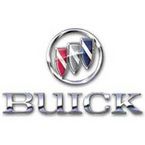
Buick (pronounced / ˈbjuːɪk/ ) is a marque of automobile sold in the United States, Canada, China, Taiwan, Qatar, Kuwait, and Israel by General Motors Corporation. Since the demise of Oldsmobile in 2004, it is GM's only North America-based entry-level luxury brand.[citation needed]
Buick originated as an independent motor car manufacturer, the Buick Motor Company, incorporated on May 19, 1903, by the Scottish-American David Dunbar Buick in Detroit, Michigan. Later that year, the struggling company was taken over by James H. Whiting (1842-1919) , who moved it to his hometown of Flint, Michigan, and brought in William C. Durant in 1904 to manage his new acquisition. Buick sold his stock for a small sum upon departure, and died in modest circumstances twenty-five years later.
Between 1899 and 1902 there were 2 prototype vehicles built in Detroit, Michigan by Walter Marr. Some documentation exists of the 1901 or 1902 prototype with tiller steering similar to the Oldsmobile Curved Dash.
In mid 1904 another prototype was constructed for an endurance run which convinced James H. Whiting to authorize production of the first models offered to the public. The architecture of this prototype was the basis for the Model B.
The first Buick made for sale, the 1904 Model B, was built in Flint, Michigan. There were 37 Buicks made that year, none of which survive.
There are, however, two replicas in existence: the 1904 endurance car at the Buick Gallery & Research Center in Flint, and a Model B assembled by an enthusiast in California for the division's 100th anniversary. Both of these vehicles use various parts from Buicks of that early era as well as fabricated parts. It is important to note these vehicles were each constructed with the two 1904 engines known to exist.
The powertrain and chassis architecture introduced on the Model B was continued through the 1909 Model F. The early success of Buick is attributed in part to the valve-in-head engine patented by Eugene Richard. The creation of General Motors is attributed in part to the success of Buick, so it can be said Marr and Richard's designs directly led to GM.
The basic architecture of the 1904 Buick was optimally engineered even by today's standards. The flat-twin engine is inherently balanced, with torque presented to the chassis in a longitudinal manner - actually cancelling front end lift - rather than producing undesirable lateral motion. The engine was mounted amidships, now considered the optimal location.
Durant was a natural, and Buick soon became the largest car maker in America. Using the profits from this, Durant embarked on a series of corporate acquisitions, calling the new mega-corporation General Motors. At first, the manufacturers comprising General Motors competed against each other, but Durant ended that. He wanted each General Motors division to target one class of buyer, and in his new scheme Buick was near the top—only the Cadillac brand had more prestige. This is the position Buick occupies to this day in the GM lineup.
At first, Buick followed the likes of Napier in automobile racing, winning the first ever race held at Indianapolis Motor Speedway.
In 1911, Buick introduced its first closed-body car, four years ahead of Ford. In 1929, Buick Motor Division launched the Marquette sister brand, designed to bridge the price gap between Buick and Oldsmobile; however, Marquette was discontinued in 1930.
Overall sales of the Buick brand peaked in the 1984 model year, when falling oil prices and the prevailing economic recovery buoyed the sales of traditional full-sized automobiles, in combination with the popularity of newer, smaller offerings and performance oriented turbocharged models. Subsequently, sales fell as downsized premium luxury coupe, full-sized and mid-sized models were poorly received by the public in the period between 1985 and 1990. The number of Buick models on offer fell over time, with the compact and performance segments being abandoned altogether.
The ideal Buick customer was comfortably well off, possibly not quite rich enough to afford a Cadillac or not desiring the ostentation of one, but definitely in the market for a car above the norm. As time goes on, Buick has become more of the traditional luxury brand in the GM group where Cadillac has become more focused on cutting edge luxury. Buick is one of the oldest marques in the world, with Mercedes-Benz, Renault, Peugeot, FIAT, Cadillac, Daimler and the discontinued Oldsmobile.
Speculation existed, however, as to whether GM will eliminate the Buick brand to cut costs. This followed the temporary suspension of GM's planned Zeta project to develop new rear wheel drive cars fitting the Buick market niche . GM also has started consolidating of Buick, Pontiac, and GMC trucks into single dealer franchises, which would make it simple to eliminate the Buick brand without leaving dealers devoid of product. However, with the development of the Zeta platform still ongoing (including the development of the 2006 VE Commodore and the new Chevrolet Camaro), it may be likely that Buick will survive still. In January of 2009, Buick unveiled the new 2010 LaCrosse sedan, a radical departure from the model it will replace in mid-2009 and from Buicks of the recent past. So far, the car has drawn praise from critics and auto journalists and adds another bright spot to Buick's stable.
Buick began consolidating its lineup in 2005, replacing the Century and Regal with the LaCrosse (known as the Buick Allure in Canada), and the LeSabre and Park Avenue with the Lucerne in 2006. Both of its SUVs, the Rendezvous and Rainier were discontinued in 2007 to make way for the new and highly successful 2008 Enclave, while the slow-selling Terraza minivan has also been dropped for '08. This leaves the marque with just three models in the United States. In 2008, Buick sales slipped from an average of four cars per dealer per month to three, in addition to two trucks. There have been rumors on Edmund's and Motor Trend that Buick will have a roadster sedan in 2010, which along with the Enclave should ensure the survival of Buick beyond 2009.
There is speculation that future Buick models will have interior and exterior designs with greatly increased influence from Buick of China. This is due to Buick's great success and high reputation in China. Motor Authority has also written that Buick will introduce the Buick Excelle in the United States in 2008 . Other Chinese designed models such as the beautiful and luxurious Park Avenue are likely to follow either as debuts or as redesigns of existing American models.
According to a July 7, 2008 ABC News report, GM was considering selling the Buick brand as a way to get out of its current financial difficulties; however, this has been refuted by more recent events where General Motors named Buick as one of the four "core brands" that it would focus on in the future.
Trishield
Buick's emblem consists of three shields, each bisected diagonally to the right by a straight line, the shields arranged touching each other in a left-diagonal pattern, inside a circle. If represented in color, the leftmost shield is red, the middle white, and the rightmost blue, although white is sometimes represented by light gray. This design, known as the Trishield, was adopted in 1959 for the 1960 models and represents the three models that comprised the lineup that year—LeSabre, Invicta, and Electra. The shields are adopted from the shield of the Buick family crest, which in modified form had been used on Buicks since the 1930s. A version of the traditional crest appeared on Electras through the 1980s.
Portholes and Ventiports
A traditional Buick styling cue dating to 1949 is a series of three or four portholes or vents on the front fender behind the front wheels. The source of this design feature was a custom car (one not made by Buick, but personal car of stylist Ned Nickles), which in addition had a flashing light within each hole, each synchronized with a specific spark plug simulating the flames from the exhaust stack of a fighter airplane. Combined with the bombsight mascot (introduced in the 1940s), the ventiports put the driver at the controls of an imaginary fighter airplane. The flashing light feature was not used by Buick in production, but the portholes remained as nonfunctional ornamentation.
These were originally called "Ventiports" as they did allow air flow into the engine bay (later just "portholes"). Ventiports have appeared sporadically on several models since.
Lower cost models were equipped with three portholes, while higher cost models came with four. Often, people would denote their cars as "Four-Holers" or "Three-Holers" to assert the car's class. When the number of portholes was standardized across the entire model line, buyers of the higher cost models complained bitterly that they felt shortchanged. In 2003 they were re-introduced on the Buick Park Avenue. After the Park Avenue was discontinued, Buick salvaged the portholes to appear on the new Lucerne. In a break with tradition, the Lucerne's portholes refer directly to engine configuration: V6 models have three on each side, while V8s have four on each side.
Sweepspear
Another styling cue from the 1940s through the 1970s was the "sweepspear", a curved line running the length of the car. In the earlier cars, this was a chrome-plated rub strip which, after it passed the front wheel, gently curved down nearly to the rocker panel just before the rear wheel, and then curved around the rear wheel in a quarter of a circle to go straight back to the tail-light. During the two-tone color craze of the 1950s, the sweepspear separated two different color areas. After that, the curved line was usually indicated either by a vinyl rub strip or simply a character line molded into the sheetmetal.
Taillight shapes
During the 1950s, the characteristic form of the Buick taillamps was a tier of small circular bullet-shapes. In the early 1960s, most models began to evolve a wide, rectangular pattern, until the '65 Skylark and Electra models appeared with full-width rear lamps. Since then, wide taillamps have been a Buick hallmark.
Dollar grin
The Buick styling cue (dating from the 1940s) that has most often reappeared, though, is for the grille to be a horizontal oval with many thin vertical chromed ribs bulging forward. This has sometimes been called the Buick "dollar grin" particularly on the early 1950s models, which had thick, highly-polished ribs that somewhat resembled teeth. The 1950 model took this tooth theme to its extreme as the teeth crossed over the bumper exposing the 1950 "grin". The 1951 model reined in the theme bringing the teeth back behind the bumper.
Waterfall Grille
It appears Buick may be preparing to abandon this styling cue for a new waterfall grille, as seen on the Buick Velite concept car from 2004 and the Buick Lucerne introduced for the 2006 model year. This waterfall grille bears some resemblance to grilles of Buicks from the 1980s, such as the Grand National.
Nailhead
The Buick V8 engine, nicknamed the "nailhead", became popular with hot-rodders in the 1950s and 1960s, because the vertical attachment of the valve covers, in contrast to the angled attachment of other V8 engines, enabled the engine to fit into smaller spaces while maintaining easy access for maintenance. It was also popular because the design was capable of producing much more torque per cubic inch than other engine designs.
By 1970, Buick was making quiet history with more conventional V-8s that had abandoned the "nailhead" design but made much greater power. For the 1970 model year, Buick re-named its "Gran Sport" performance models (not to be confused with the Chevrolet Corvette "Grand Sport" cars) as "GS" models, and initially this was headed up by the powerful GS455 Stage 1, so named for its 455 cubic inch (7.4L) engine, with its high performance "Stage 1" package. Built on the same "A-body" platform as the Chevelle, Cutlass/ 442, and LeMans/ GTO, the GS cars were performance based vehicles spawned from Buick's Skylark line, and shared all of the A-Body GM offering's tendency for good looks. Both hardtop and convertible "GS" models were offered.
GSX
Midway through that year, Buick debuted its "GSX" model, which was an appearance package rivaling that of the GTO "Judge". GSX colors ran the spectrum that year, if that range included just yellow and white. Subsequent GSX models offered a variety of colors to go with the GSX signature hood blackout treatment and the swept wide pin striping vaguely reminiscent of the famous Buick "sweepspear". GSX models could be ordered with 350, 455, or 455 Stage 1 engines, and were outfitted with the usual GS options such as dual hood scoop hood with functioning "ram-air" intake, and dual exhaust. Horsepower ratings for the Stage 1 455s were a relatively mild 360 hp (or 370 depending on sources), but featured a pavement-tearing 510ft·lbf (690N·m) of torque at 2200 rpm, good to propel the relatively weighty GS455 Stage 1 equipped cars to quarter-mile times under 13.4 seconds. Buick halted GSX production after the 1972 model year.
The prototype GSX survived the show circuit, and was a fully functioning car that beat the odds to survive not only the usual showcar life of "construction-display-destruction", but also the life of an ordinary car, as it was sold from a dealership after being on display for some time. The car survives to this day, is restored to its original condition, licensed and ready to hit the road.
Unlike some of GM's other brands, Buicks are currently not marketed globally, although the marque had a substantial export presence until a few years ago. Some Buicks were also built in Europe or were available with specific trim for European market until 1996.
In pre-World War II China, one in five cars were Buicks. The brand is popular in China also nowadays.
Currently most Buick sales are sold in the United States and Canada. However, Buick has attracted a considerable market in a few countries.
Buick in New Zealand
Buicks were once sold in New Zealand. Back then, they were also built at the GMNZ plant in Petone, outside Wellington. At the end of World War II, the Buick name was not revived.
Buick in Israel
In Israel, Buicks are imported by Universal Motors, Ltd. (UMI), which also imports other GM vehicles. For MY 2004 and 2005 the Buick LeSabre and Buick Rendezvous were sold. For the MY 2006 and 2007, the Buick LaCrosse and Buick Lucerne were sold alongside the Rendezvous. For the MY 2008, the Buick LaCrosse and Buick Lucerne are available.
Buick in the Middle East
Buicks were sold throughout the Middle East until the second-generation Buick Roadmaster was discontinued.
Buick in China
General Motors, selling vehicles under the Buick, Chevrolet, Opel, Saab and Cadillac names, is the best-selling foreign automaker in China. Selling a combined 876,000 vehicles in 2006, GM overtook Volkswagen the year before, although that company still holds the claim on best selling brand. Making up nearly 35% of those sales, China is Buick's largest market, selling more there than even the United States. In 2007, General Motors sold over 330,000 Buicks in China, more than twice what they sold in the United States.
Since 1999, a Chinese version of the Buick Century/ Regal has been produced and sold in China under Shanghai GM and has proven to be popular among upscale, professional families, establishing Buick as one of the most popular vehicle brands in China. In addition, Buick of China also sells the compact Excelle (based on the Daewoo Lacetti/ Nubira), a five-door hatchback version called the HRV, and a modified version of the first generation Pontiac Montana minivan named the GL8. Chinese market Buicks are equipped with smaller engines than the same nameplate in the American market; in 2008 General Motors began importing these engines from China for use in the American Chevrolet Equinox and Pontiac Torrent.
In June 2005, Buick announced that it would market the Australian Holden Statesman in China as the Buick Royaum. Buick previously marketed the subcompact Sail, sourced from GM's Asian operations and based on the Opel Corsa B, until 2005. Since then, Shanghai GM has replaced it with the Chevrolet Sail (a rebadged Opel Corsa). Buick has stated that it expects China to become its second largest market.
For the 2006 model year, Buick debuted the Chinese version of the LaCrosse sedan. The only differences are exterior design, different engine choices, and a facelifted interior. It is positioned above the Regal but below the Royaum.
In April 2007, Shanghai-GM announced the Buick Park Avenue, for the Chinese market only. The vehicle is based on the Holden Statesman, with engines manufactured in Australia.
Buick in Taiwan
GM Taiwan was founded in August 1989. In the early 1990s, Buick, along with other GM brands, was very popular and frequently seen on Taiwanese streets. Park Avenue, 3rd & 4th generation Regal, and 6th generation Skylark used to be sold in Taiwan.
In December 2004, General Motors signed a memorandum of understanding with Yulon, a firm based in Taiwan, for the licensed manufacture of Buick vehicles there. In July 2005, Yulon GM Motor Co. Ltd. (Yulon GM), a joint venture with 51 percent equity stake held by Yulon Motor and 49 percent by GM was founded.
On April 17, 2006, Yulon-GM debuted the first Buick vehicle ever built in Taiwan, the LaCrosse sedan. It is very similar to the Greater Chinese regional version of the LaCrosse.
Current Models
- Buick Allure (2005 — Current, only sold in Canada, same as the LaCrosse)
- Buick Enclave (2008 — Current)
- Buick GL8 (2000 — Current, only sold in China)
- Buick HRV (2004 — Current, only sold in China)
- Buick LaCrosse (2005 — Current)
- Buick Lucerne (2006 — Current)
- Buick Park Avenue (2007 — Present, only sold in China)
- Buick Regal- Only sold in China for time being, coming to US in 2011
Discontinued Models
- Buick Apollo (1973 — 1975)
- Buick Centurion (1971 — 1973)
- Buick Century (1936 — 1942, 1954 — 1958, 1973 — 2005)
- Buick Electra (1959 — 1990)
- Buick Estate Wagon (1940, 1946- 1964, 1970 — 1996)
- Buick Excelle (2003 — Current, rebadged Daewoo Nubira, only sold in China)
- Buick G-series (1999 — 2003, rebadged Buick Century, only sold in China)
- Buick Gran Sport (1965 — 1972)
- Buick GSX (1970 — 1972)
- Buick Invicta (1959 — 1963)
- Buick LeSabre (1959 — 2005)
- Buick Limited (1936 — 1942, 1958)
- Buick Master Six Sedan c1926
- Buick Master Six Touring c1926
- Buick Park Avenue (1991 — 2005)
- Buick Rainier (2004 — 2007)
- Buick Reatta (1988 — 1991)
- Buick Regal (1973 — 2004)
- Buick Rendezvous (2002 - 2007)
- Buick Riviera (1963 — 1993, 1995 - 1999)
- Buick Roadmaster (1936 — 1958, 1991 — 1996)
- Buick Royaum (2005 — 2006, only sold in China)
- Buick Skyhawk (1975 — 1980, 1982 — 1989)
- Buick Skylark (1953 — 1954, 1961 — 1972, 1975 — 1998)
- Buick Somerset (1985 — 1987)
- Buick Special (1936 — 1958, 1961 — 1969)
- Buick Sport Wagon (1964 — 1972)
- Buick Standard Coach c1926
- Buick Super (1940 — 1958)
- Buick Terraza (2005 - 2007)
- Buick Wildcat (1962 — 1970)
Companion make
- Marquette
Concept vehicles
- Buick Y-Job (1938)
- 1951 Buick LeSabre (1951)
- Buick XP-300 (1951)
- Buick Wildcat I (1953)
- Buick Wildcat II (1954)
- Buick Wildcat III (1955)
- 1956 Buick Centurion (1956)
- Buick Riviera Silver Arrow I (1963)
- Buick Questor (1983)
- 1985 Buick Wildcat (1985)
- 1988 Buick Lucerne (1988)
- Buick Bolero (1990)
- Buick Sceptre (1992)
- Buick XP2000 (1996)
- Buick Signia (1998)
- Buick Cielo (1999)
- 2000 Buick LaCrosse (2000)
- Buick Blackhawk (2000)
- Buick Bengal (2001)
- Buick Centieme (2003)
- Buick Velite (2004)
- Buick Riviera (2007)
- From a Buick 8, a horror novel by Stephen King, is about a car with supernatural powers.
- In John Updike's Rabbit, Run, the Episcopalian clergyman Eccles drives a Buick, a symbol of the American way of life.
- The Phantom Regiment euphonium section is affectionately called the "Buicks", after a fan's comparison of the section's sound to "a fleet of Buicks coming at [them]". **quote taken from the DCI on ESPN2 Telecast**
- In the Wideload game, Stubbs the Zombie in "Rebel Without a Pulse", all of the unmovable cars that are portrayed as hovercars in the game are either Buicks circa 1955, or Chevrolet Bel Airs circa 1957.
- Bob Dylan's 1965 album Highway 61 Revisited featured a song called "From a Buick 6".
- In the 1992 comedy film Stay Tuned, John Ritter's character as a mouse said that the donuts were "As Big as Buicks".
- Bruce Springsteen, in his song "My Hometown", sings "I'd sit on his [father's] lap in that big old Buick and steer as we drove through town."
- In 1988, Thomas Dolby released his third album, entitled Aliens Ate My Buick.
- In the 1977 comedy film Annie Hall, Woody Allen's character says a spider is "the size of a Buick."
- In the 1987 epic war film Empire of the Sun, John Malkovich drove a Buick 38.
- In the 1988 Academy Award winning film Rain Man, a 1949 Buick Roadmaster convertible is featured prominently.
- In the 1993 film Addams Family Values, Gomez Addams demands a subpoena be issued to Fester Addams' wife, Debbie, because Gomez believes they own a Buick.
- In the 1999 horror film House on Haunted Hill, one of the characters says "someone or something just tried to drown me in a vat of blood the size of a Buick."
- in the 1999 game Crazy Taxi, Gus, one of the cabdrivers drives a 1949 Buick.
- In the song "Larger than Life", the movie theater organ is referred to as "as big as a buick".
- In the 2003 film Sin, Charlie Storm drives a Buick Riviera.
- In the 2006 Academy Award-winning film The Departed, the character played by Jack Nicholson is driven in a 1994 Buick Roadmaster.
- In the 2006 film Crank (film) Jason Statham's character drives a 1972 Buick Riviera.
- E. E. Smith's "Skylark" novel series is rumored to be named after the Buick Skylark. Heinlein's "Expanded Universe" mentions an encounter between Heinlein, Smith and a Buick Skylark.
- In the 2007 AMC TV series Mad Men, which is set in 1960, the main character drives a 1959 Buick LeSabre coupe.
From Wikipedia, the free encyclopedia
More About Buick
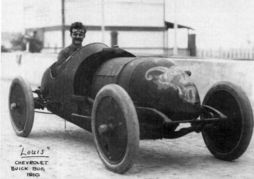
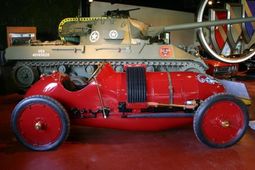



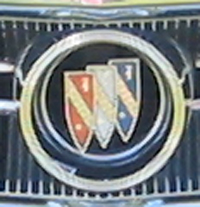
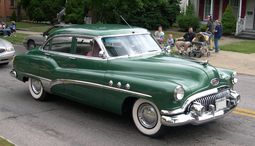

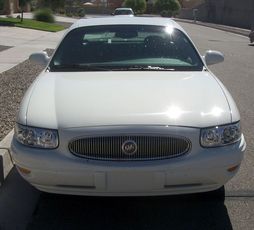

|